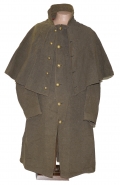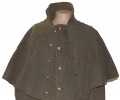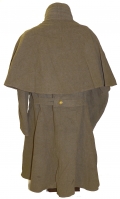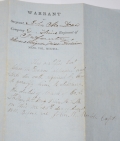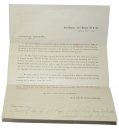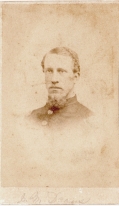site search
online catalog
MASSACHUSETTS MILITIA OVERCOAT IDENTIFIED TO MEDAL OF HONOR RECIPIENT, WITH NOTE DOCUMENTING ITS ISSUE ON THE TRIP TO FORTRESS MONROE IN APRIL 1861 - 3rd MASSACHUSETTS VOLUNTEER MILITIA AND 29th MASSACHUSETTS (IRISH BRIGADE)

$9,950.00 SOLD
Originally $11,000.00
Quantity Available: None
Item Code: 1041-111A
NOTE: THE IMAGE OF LT. DEANE INCLUDED BELOW DOES NOT ACCOMPANY THE GROUPING.
This rare, early war overcoat is from the archive of Lt. John Deane, who was one of the Massachusetts Minute Men of 1861, called into active service on the afternoon of April 15, 1861, and hastily rushed south on April 18 with the 3rd Mass Volunteer Militia. In addition, once the 3rd had been discharged, Deane joined the 29th Mass Volunteers, which served in the Irish Brigade through the Battle of Antietam. Deane served throughout the war, rose to the rank of major, and won the Congressional Medal of Honor for his actions at Fort Steadman on March 25, 1865.
Deane was a resident of Freetown, MA when he enlisted on 4/23/61 as a 2nd Lieutenant. On that date he was commissioned into Company G, 3rd Massachusetts Infantry. He mustered out on 7/22/61 at Boston. On 6/1/62 he was commissioned into the 2th Massachusetts Infantry. Promoted to 1st Lieutenant on 12/29/62; Adjutant on 11/1/63; Captain on 6/8/64; Major by Brevet on 3/25/65, and Major on 5/15/65. He mustered out on 8/8/65.
This coat matches the specifications for overcoats made up by the State of Massachusetts from 6,000 yards of gray beaver cloth it ordered in February 1861. Todd describes the coats as well made and, “of a medium iron-gray color lined with red wool.” The coat may have been from this lot or made to follow the pattern. The fabric retains its gray color and is soft to the touch. The exterior shows just minor wear, most notably on the cuff edges, as is to be expected. In form it follows the federal pattern, which Massachusetts tried to do in its uniform specifications. The collar is a simple stand-up collar stiffened with horizontal row of stitching. The cape is sewn into the base of the collar and would extend to the elbow, just as the federal overcoat. The coat is single breasted, fastened by six brass buttons down the front, has a single vent in skirts at rear, and an adjustment belt with two button holes and a single button to fasten it. The cape is unlined and is fastened with five smaller brass buttons. The only real exterior difference from the federal coat, aside from color, is the use of Massachusetts Volunteer Militia buttons with backmarks reading, “*J.M.L. & W.H. Scoville* Waterbury/ Extra Superfine.”
The interior of the coat is similar to the federal issue as well, with plain white sleeve linings and body lining only to the waist. In this case, however, as mentioned by Todd, the body lining is red. A single breast pocket on the wearer’s left us well made, overlapping the red and gray fabric. The lining has a little scattered mothing and a few wear spots, but nothing very unsightly and completely without effect on the integrity of the coat.
With this coat are two warrants - the first appoints Deane sergeant in the 3rd Mass. Vol. Militia in August 1860; the second appoints Deane Third Lieutenant of that unit. Also included is a General Order dated February 1861 with a note that he had received it as lieutenant of Co. G.
But, one of the best things about the coat is the wonderful period pencil note of provenance and history that reads: “Army Overcoat – Issued by the State of Mass. to Lieut. John M. Deane Co. G 3rd Regt. Mass Vol Militia On board the Steamer S.R. Spaulding en route for Fortress Monroe, Va. April 1861.” Deane preserved a number things that we are proud to offer, but this is a remarkable relic of a particular and significant moment in time when volunteer militia raced to preserve the Union. It is indicative of their rush to serve that they had not even had time to draw overcoats before embarking on their transports to the seat of war. [SR]
--------------------------------------------------
John Milton Deane (January 8, 1840 - September 2, 1914), was an American Civil War Medal of Honor recipient and a major in the United States Army. Deane was born in Assonet, Massachusetts to John and Lydia (Andros) Deane. He attended local schools in Assonet and Myricks, and later at the Foxboro English and Classical School. After completing his own schooling, Deane served as a schoolteacher in Berkley and Assonet. Deane enlisted in the Assonet Light Infantry in September, 1858.
Following the war, Deane was a member of GAR Post #46 (Richard Borden) in Fall River, MA. On November 20, 1866, Deane married Mary Gray Pearce (1846–1923). She was the daughter of Abner Tompkins and Sarah Read (Briggs) Pearce. He was elected a resident member of the Old Colony Historical Society in 1902.[2] On September 2, 1914, John Deane died at the age of 74. He is buried in the Assonet Burying Ground.
In 1989, a ceremony was held in the Assonet Burying Ground during which a government marker was placed on Deane's grave. In 2005, Deane's diaries from the period 1861-1865 were published by the Freetown Historical Society as Civil War Diaries of Maj. John M. Deane, Medal of Honor Winner, 1861-1865.
Medal of Honor Citation:
In a letter dated March 8, 1895, Col. W. F. Ainsworth informed Deane that he had been awarded the Medal of Honor "for most distinguished gallantry in action at Fort Steadman, Virginia, March 25, 1865, in serving with other volunteers, a previously silenced and abandoned gun, mounted en barbette, at Fort Haskell, being exposed to a galling fire from the enemy's sharpshooters."
-----------------------------------------------------
The 3rd Massachusetts Militia was organized for active service on April 15, 1861 in response to President Lincoln's call for 75,000 troops to put down the insurrection in the southern states. Despite the various companies being dispersed over a large area of southeastern Massachusetts, Col. Wardrop managed to get word to the captains under his command during the night of April 15–16.[6] The 3rd Massachusetts was among the first Massachusetts regiments to report for service in Boston on April 16.[1] The unit was therefore one of several Massachusetts regiments which became known as the "Minutemen of '61," in reference to the Minutemen who turned out in April 1775 during the Battles of Lexington and Concord.
The 3rd Massachusetts reported to Boston with an incomplete roster of seven out of ten companies. Three newly recruited companies were therefore added to the unit to fill out their ranks. These three new companies, primarily from the Boston area, had enlisted for three years as opposed to the 90 day service for which the bulk of the regiment had enlisted. After the 3rd Massachusetts was mustered out in July 1861, the new companies were eventually transferred to the 29th Massachusetts to serve out the remainder of their term.
The regiment arrived via ship at Fortress Monroe, a Union foothold on the Virginia coast, in the morning of April 20, 1861. That afternoon, they were loaded on board the USS Pawnee and taken to the Gosport Navy Yard across Hampton Roads at Norfolk. The Navy yard, its vessels, and valuable stores were expected to fall into Confederate hands. Therefore, the 3rd Massachusetts was given orders to set fire to all buildings, vessels and stores. Col. Wardrop felt the strategic location could be defended and offered to deploy the 3rd Massachusetts to hold the position. This request was denied and details were ordered to go about firing the Navy yard. The 3rd Massachusetts returned aboard the Pawnee which towed the USS Cumberland to Fortress Monroe, saving the frigate from falling into enemy hands. In executing this assignment, the 3rd Massachusetts claimed that they were the first Union troops to make an incursion on territory held by the Confederacy.
During May and June 1861, the 3rd Massachusetts was garrisoned at Fortress Monroe and conducted occasional patrols beyond the fort. On July 1, the regiment was ordered to occupy the town of Hampton, Virginia just four miles from the fort. Confederate forces were massing nearby at Big Bethel and the post was considered a dangerous one due to the proximity of the enemy and the secessionist sentiments of the local population. One soldier of the 3rd Massachusetts was shot and beaten while at Hampton, though he survived.
On July 16, the regiment marched to Fortress Monroe and boarded a steamship for Boston. They were mustered out at Camp Wightman on Long Island in Boston harbor on July 22.
-------------------------------------------------------------
The 29th Regiment Massachusetts Volunteer Infantry was an infantry regiment in the Union army of the United States during the American Civil War. The regiment was organized in December 1861 when three new companies were attached to a battalion of seven Massachusetts companies that had been in active service since May 1861. These seven companies had been recruited to fill out the 3rd Massachusetts and 4th Massachusetts regiments and had signed on for three years of service. When the 3rd and 4th Massachusetts were mustered out in July 1861, the seven companies that had signed on for three years were grouped together to form a battalion known as the Massachusetts Battalion. Finally, in December 1861, three more companies were added to the roster to form a full regiment and the unit was designated the 29th Massachusetts.
The regiment took part in 29 battles and four sieges in a variety of theaters of the war. After their early service at Fortress Monroe in Virginia, the 29th was attached, in the spring of 1862, to the Army of the Potomac during the Peninsular Campaign as part of the famed Irish Brigade. The 29th had the distinction of being the only regiment of non-Irish ethnicity to serve in that brigade. In January 1863, the IX Corps (including the 29th Massachusetts) was transferred to Kentucky and engaged in operations against Confederate guerillas. In the summer of 1863, the IX Corps was again transferred and took part in the Siege of Vicksburg and the Siege of Jackson, Mississippi. In the fall of 1863, IX Corps took part in the Knoxville Campaign which resulted in the defeat of Confederate forces in eastern Tennessee. The spring of 1864 saw the IX Corps and the 29th Massachusetts once again returned to duty with the Army of the Potomac, just in time to take part in the Overland Campaign and the Siege of Petersburg. During the Siege of Petersburg, the unit suffered their worst casualties of the war in the Battle of Fort Stedman on March 25, 1865. The 29th was mustered out of service on August 11, 1865. Including the seven months served by most of the regiment before its designation as the 29th, the unit had one of the longest terms of service of any Massachusetts regiment—a total of four years and three months.
During the winter and early spring of 1862, the 29th was deployed on various minor expeditions near Fortress Monroe, Newport News and Norfolk, Virginia. On March 8 and 9, the regiment was present during the Battle of Hampton Roads, a naval engagement fought primarily between the USS Monitor and the CSS Virginia. The regiment helped man a land battery during the engagement, and the men of the 29th were amazed by the new ironclad vessels and the changes they brought to naval warfare.
In the middle of March, once again at Fortress Monroe, the 29th witnessed the arrival of the Army of the Potomac, commanded by Major General George B. McClellan. McClellan intended to use Fortress Monroe as his base of operations for an assault on the Confederate capital of Richmond. The effort would be known as the Peninsular Campaign. Over the course of March 1862, the men of the 29th watched as roughly 100,000 Union soldiers and 15,000 mules and horses debarked from Fortress Monroe. The 29th was to remain at Fortress Monroe as the Army of the Potomac made its way toward Richmond. As the campaign became bogged down outside the Confederate capital, additional troops were called for and the 29th Massachusetts departed Hampton Roads on June 7, 1862.
Traveling by steamboat up the York River, the 29th arrived at White House Landing and marched to the battle front on June 8, 1862. The regiment was attached to the Irish Brigade (2nd Brigade, 1st Division, II Corps). Contemporaries and historians alike have wondered at this unusual assignment. The 29th Massachusetts was made up of men descended, largely, from old-stock English families, some with heritage dating back to the Mayflower. There was, at the time, significant social friction in New England between established Protestant families and Irish immigrants. While the regimental historian observed that the 29th was "cordially welcomed" to the Irish Brigade, other historians, such as Marion Armstrong, point out the oddity of the "aristocratic 29th Massachusetts ... thrown in with three regiments of New York Irishmen." Historian Daniel Callaghan quotes period sources describing the "unlikely matching of ancient political foes," and the manner in which the men of the 29th tolerated the Irish-born commander of the Irish Brigade, Brig. Gen. Thomas Francis Meagher, "coldly, in a pinched and critical silence."
Despite these social differences, the 29th Massachusetts fought alongside the Irish regiments through heavy combat (the first the regiment had seen) during the Seven Days Battles. During this series of battles, the Confederates drove McClellan's army away from Richmond, resulting in the failure of the Peninsular Campaign. After the Union retreat, Meagher praised the 29th's actions in battle saying that they "had proved themselves the equals of any others in the Brigade, and had no superiors in the army." Meagher would later call the 29th "Irishmen in disguise." During the Seven Days Battles, the 29th suffered moderate casualties of six killed and 18 wounded. These casualties included Peirce whose right arm was shot off by cannon fire. Command of the regiment then fell to Barnes.
Following the failure of the Peninsular Campaign, elements of the Army of the Potomac were shipped to northern Virginia to provide assistance to Union Maj. Gen. John Pope. Pope had been attempting to open a second assault on Richmond from the north, but he was defeated during the Second Battle of Bull Run on August 30, 1862. The 29th Massachusetts, along with other elements of the II Corps, arrived too late to take part in the battle.
After his victory at Bull Run, Confederate Gen. Robert E. Lee invaded Maryland in September 1862. The Army of the Potomac, including the 29th Massachusetts, moved to intercept the Confederate offensive. The two armies clashed at Sharpsburg, Maryland, during the Battle of Antietam on September 17, 1862.
The battle commenced in the early morning with several assaults on the Confederate left flank by the I Corps and the XII Corps. After these failed, the II Corps, including the Irish Brigade, was called upon to assault a position near the Confederate center known as the "Sunken Road" or "Bloody Lane." The trench-like road afforded the Confederates a strong defensive position. Just after 9 a.m., Maj. Gen. Israel B. Richardson's division, with the Irish Brigade in the lead, moved toward the Sunken Road. Meagher envisioned the delivery of a few volleys from the brigade followed by an impetuous charge. As the Irish Brigade advanced up the crest toward the Sunken Road, it took heavy fire from the Confederates. The progress of the brigade was slowed by a sturdy split rail fence. When Meagher asked for volunteers to run forward and take it down, Corporal Samuel C. Wright of the 29th sprang forward with several others. Wright recalled that many were shot down before they reached the fence and, as "one would grasp a rail, it would be sent flying out of his hands by rifle shots." The dash back to the lines was just as dangerous. Cpl. Wright was later awarded the Medal of Honor for his bravery at Antietam. He would, over the course of successive battles, be wounded five times and reported dead twice. Despite his travails, he survived the war. The Irish Brigade, though advancing in good order under heavy fire and delivering effective fire in return, did not reach the Sunken Road. The brigade retired, the regimental historian observed, "as steadily as on drill." The 29th has been criticized by some historians, including Marion Armstrong, for not advancing as quickly as the rest of the Irish Brigade. An accident in the terrain, a small rise in front of the 29th's position, afforded them cover, and their casualties were lighter than those of the other regiments of the brigade. Armstrong argues that Barnes was reluctant to leave this advantageous ground, a factor which may have contributed to the failure of the Irish Brigade's charge. The casualties of the 29th were nine killed, 31 wounded and four missing.
The Battle of Antietam had been a tactical stalemate. McClellan claimed it as a strategic victory as Lee's army retreated back into Virginia. Despite this, President Lincoln was displeased with McClellan's failure to pursue Lee and replaced him with Maj. Gen. Ambrose Burnside. During November 1862, Burnside proceeded to gather the Army of the Potomac in Falmouth, Virginia, preparing to assault Lee's army across the Rappahannock River in Fredericksburg, Virginia.
While in camp in Falmouth in late November, the officers of the 29th learned that Meagher had arranged for a green Irish Brigade flag to be presented to the regiment, recognizing their role as "honorary Irishmen" and their bravery during the Battle of Antietam. Barnes declined the gift, however. According to the regimental historian, "While the Colonel would have been proud to receive the flag for the regiment as a token of the respect of their Irish comrades, yet he objected to the flag being carried by the regiment, on the ground that it was not an Irish regiment." Irish Brigade historians, including Joseph Bilby, have observed that there may have been some controversy surrounding the issue. According to Bilby, Barnes refused to accept the flag because they believed it "would brand them as Fenians," or Irish revolutionaries.
As a result of this incident, on November 30, 1862, the 29th was transferred out of the Irish Brigade and into Brig. Gen. Benjamin C. Christ's brigade in the IX Army Corps. It was replaced in the Irish Brigade by the2 8th Massachusetts, an Irish regiment. The transfer spared the 29th from the Battle of Fredericksburg in which their new brigade played almost no role. Their former comrades in the Irish Brigade, however, made a harrowing charge during the battle and suffered severe casualties.
Following his failure during the Battle of Fredericksburg, Burnside was removed from command of the Army of the Potomac and returned to the command of the IX Corps, to which the 29th Massachusetts now belonged. On February 5, 1863, the IX Corps was detached from the Army of the Potomac and transferred from Virginia to Kentucky where Burnside was to take command of the Department of the Ohio and Union operations in Kentucky and east Tennessee. The 29th Massachusetts reached Cincinnati via railroad on March 26, then marched into Kentucky. They were stationed in Paris, Kentucky, during April 1863, conducting light duty in defending against occasional raids by Confederate guerrillas. In late April they marched to Somerset, Kentucky, where they were occupied with similar duty until early June 1863. In early June, most of the IX Corps was transferred to the command of Maj. Gen. Ulysses Grant who required reinforcements in the Siege of Vicksburg, the last major Confederate stronghold on the Mississippi River. The 29th Massachusetts traveled with other elements of the IX Corps via steamship down the Ohio and Mississippi Rivers. They arrived in the vicinity of Vicksburg in late June and began digging entrenchments. Less than two weeks after the regiment arrived in Mississippi, the city of Vicksburg surrendered on July 4, 1863. Following the surrender of Vicksburg, the remaining Confederate forces in Mississippi concentrated in the state capital of Jackson.
Maj. Gen. William Tecumseh Sherman took several corps of Unions troops, including the IX Corps, and laid siege to Jackson in mid- July. While digging trenches, the 29th was exposed to heavy artillery and sharpshooter fire from the Confederates, but the regiment suffered only one casualty during the siege. During the night of July 16, the Confederate army in Jackson managed to slip away from the city and the siege was ended.
Shortly afterward, the IX Corps was recalled to Kentucky, as Burnside was eager to begin his operations in Tennessee. On the way back to Vicksburg, the 29th acted as provost guard, marching at the rear of the IX Corps to gather stragglers. They missed the first group of steamships to depart for Cincinnati and had to wait three weeks, until August 12, with other regiments at a camp in Milldale, Mississippi, near Vicksburg. Camp conditions were unsanitary and the weather extremely hot. Many of the men suffered from disease during and after this encampment. As the regimental historian wrote, "Deaths were very frequent among the troops here during this time, burial parties were almost constantly engaged, and the funeral notes of the fife and drum could be heard nearly every hour in the day. None save the strongest came out of that campaign in sound health.
Burnside gathered his Army of the Ohio in the vicinity of Lexington, Kentucky, in late August 1863 in preparation for an invasion of eastern Tennessee. The region was strategically important as a rail link between Virginia and Chattanooga. Also, the population of eastern Tennessee was primarily Unionist. Therefore, it became a key strategic goal of Lincoln's to force Confederate troops out of the region in hopes that Unionists would gain support and bring the state back into the Union. Prior to the march, half of the men in the 29th were on the sick list as a result of their service in Mississippi, including Barnes, who took an extended leave and returned for a time to Massachusetts. In his absence, Peirce returned to the 29th to command the unit. The march across Kentucky, through the Cumberland Gap and on to Knoxville, Tennessee, was one of the longest marches the 29th ever executed—a distance of more than 200 miles covered between September 1 and September 26, 1864.
On October 21, the IX Corps made camp in and around Lenoir City, Tennessee, and remained there until November 14, 1863. During this time, Confederate Lt. Gen. James Longstreet launched an offensive aimed at the expulsion of Burnside's troops from Knoxville. The IX Corps, including the 29th Massachusetts, moved southwest to meet the Confederates near Loudon, Tennessee. Union forces were rapidly repulsed and retreated to Knoxville. The siege of that city by the Confederates began in mid-November 1863. The 29th's position during the siege was within Fort Sanders. When Longstreet launched his assault on Fort Sanders on November 29, 1863, the 29th saw heavy action in repulsing the Confederates. Two members of the 29th, Sgt. Jeremiah Mahoney and Pvt. Joseph S. Manning, later received the Medal of Honor for their bravery in capturing two Confederate battle flags during the battle. The 29th lost only two killed in the Battle of Fort Sanders owing to the strength of their position on the walls of the fort.
Following this Union victory and the retreat of Longstreet's troops to Virginia, the 29th was stationed in mid-December 1863 at Blaine, Tennessee, about 20 miles northeast of Knoxville. Camped on an open plain, exposed to wind and snow, and running very low on provisions, the regiment suffered severely during December 1863 and January 1864 and referred to the camp at Blaine as their Valley Forge. At the end of December, Barnes rejoined the 29th as its commander and Peirce was elevated to brigade command.
In January 1864, with the end of their three-year term of service only four months away, the men of the 29th were given the option to reenlist for another three years. Those men who chose to accept the offer would receive a 30-day furlough, while those that did not would be consolidated with the 36th Massachusetts to serve out their remaining months. A total of 166 men chose to reenlist and approximately 90 did not. On March 21, 1864, the 29th and the IX Corps commenced their long march back to Ohio via the Cumberland Gap, reaching Cincinnati on April 1, 1864. From there, the men who had reenlisted were sent back to Boston for the furlough they had been promised and those who had not were sent on to Virginia to join the 36th Massachusetts.
While the remaining men of the 29th were on furlough in Massachusetts, Lt. Gen. Ulysses Grant, as general-in-chief of the Union Army, began the Overland Campaign. During the spring of 1864, he would direct the actions of the Army of the Potomac in northern Virginia, aggressively pushing Lee's Confederate army toward Richmond in a series of major battles. The men formerly of the 29th who had been transferred to the 36th Massachusetts took part in the opening battles of the campaign, the Battle of the Wilderness and the Battle of Spotsylvania Court House, incurring casualties of seven killed and 30 wounded out of a total of 90 men. This detachment fulfilled their three-year enlistment in mid-May 1864 and returned home. The furlough for the newly reenlisted ended on May 16 and the 29th Massachusetts, now a small fraction of its original size, departed for Virginia. They rejoined the Army of the Potomac on May 20, 1864, just in time to take part in the closing battles of the Overland Campaign, particularly the Battle of Cold Harbor. On June 1, 1864, the regiment suffered casualties of one killed, 12 wounded and three captured during Grant's first assault at Cold Harbor. Although the regiment had been temporarily assigned to the V Corps, on June 3 it rejoined the IX Corps. Over the next nine days, the regiment-built breastworks and served on picket duty until June 12 when IX Corps rapidly marched to the outskirts of Petersburg, Virginia, in preparation for an assault on that city.
In the pre-dawn hours of June 17, the divisions of the IX Corps formed up for an assault on the entrenched Confederate position outside Petersburg. Barnes of the 29th had been elevated to command of the 2nd Brigade, 1st Division of the IX Corps, to which the 29th belonged. Major Charles Chipman was placed in command of the 29th in his stead. While other divisions of the IX Corps attacked and were repulsed, the 1st Division moved to its assigned position in the late afternoon and lay down, studying the Confederate breastworks and awaiting orders to advance. At first, the division, to its relief, received orders that the attack had been called off. A short time later, however, came the order to attack. The division, including the 29th, charged from their protected position in a ravine out into an open plain in front of the Confederate entrenchments. According to the regimental historian, "They had scarcely emerged upon the open plain, when the whole crest of the Confederate works was fringed with fire and smoke; grape, canister, and musket balls filled the air." During this charge, the color-bearer of the 29th, Sgt. Silas Grosvenor, was shot through the head. The colors were picked up by Sgt. John A. Tighe who was also killed. Sergeant Major William F. Willis picked up the flag and became the third color-bearer killed in the charge. At this point, the 29th was forced to pause in its advance and retired a short distance. In the confusion, the colors were left on the field. Major Chipman asked for two volunteers to go with him onto the open ground to retrieve the colors. The three found the colors and, according to the regimental historian, the Confederates, admiring the bravery of the trio, did not fire and allowed them to return to their lines. The 1st Division of the IX Corps eventually captured the Confederate works in their front, however little had been accomplished by the assault on Petersburg overall. The Confederates remained strongly entrenched and the long Siege of Petersburg began. The 29th, numbering just 100 men at this time, lost six killed and 23 wounded.
The 29th occupied trenches outside Petersburg with the rest of the Army of the Potomac during the summer of 1864. In July, Union troops dug a mine beneath the Confederate position and, on July 30, 1864, a massive amount of gunpowder was detonated in the mine, blasting a hole in the Confederate position. During the resulting Battle of the Crater, the 1st Division of the IX Corps led a confused and failed attack. The 29th took part, charging into the crater with other regiments and eventually retreating, losing three killed, seven wounded and six captured.
The 29th played a minor role in the Battle of Globe Tavern, a movement intended to tighten the siege around Petersburg, on August 18, 1864. The regiment suffered only a few casualties during this engagement. In the fall of 1864, the 29th served uneventful duty along the Petersburg siege lines and was eventually, in November, assigned a garrison post in Battery 11, a small, unfinished ravelin (detached fortification) outside of Fort Stedman. Stedman was one of many earthen fortifications built along Union lines during the siege, and was only 150 yards from the Confederate trenches—the narrowest distance between the two armies. They would remain at this post for the next four months.
On March 25, 1865, the regiment fought in the Battle of Fort Stedman, the Confederate Army's final offensive during the Siege of Petersburg. Before dawn on March 25, Confederate troops achieved complete surprise and easily occupied Fort Stedman entering the rear sally port almost unchallenged. Major Charles T. Richardson, then in command of the 29th, hearing some light gunfire, ordered the 29th to fall in. No general alarm had yet been raised, but Richardson felt certain that an attack was underway. Within minutes, approximately 500 Confederates, a small part of the overall offensive, swept over Battery 11. The 29th held their ground, however, engaging in heated hand-to-hand combat and eventually capturing 300 Confederates—more than twice their own number. The Confederates still occupied Fort Stedman, however, and soon sent another offensive to occupy Battery 11. This time, the 29th was forced to retreat back to Fort Haskell, the nearest defensible position. Among the 29th's casualties in this engagement was Sgt. Calvin F. Harlow who, finding himself surrounded by Confederates, refused to surrender. He and the Confederate officer demanding his surrender shot each other simultaneously. Poet Walt Whitman, learning of Harlow's story, wrote about him in his book Specimen Days.
After four hours, the Confederate attack lost momentum, and their forces began to pull back into Fort Stedman. An overwhelming Union counterattack eventually recaptured the fort. The 29th took part in the counterattack, re-capturing Battery 11. Color-bearer Conrad Homan of the 29th was the first to re-enter Battery 11 and was later awarded the Medal of Honor. The regiment lost 10 killed and an unknown number of captured in this engagement. The 29th did not take part in the pursuit of Lee's army during the Appomattox Campaign. The small regiment was instead withdrawn to Washington shortly after Lee's surrender and served as provost guards in the capital. On August 11, 1865, the 29th was mustered out of service. Approximately 173 of its members (roughly 15 percent) were killed in action or died of wounds or disease. Official numbers as to the number of wounded are not available. The unit served in 15 states and traveled more than 4,200 miles. Taking into account the seven months of duty served prior to the official formation of the regiment, plus a term of reenlistment served by many members, the 29th Massachusetts had one of the longest terms of service of any Massachusetts regiment, a total of four years and three months.
~~~~~~~~~~~~~~~~~~~~~~~~~~~~~~~~~~~
THIS ITEM, AS WITH ALL OTHER ITEMS AVAILABLE ON OUR WEB SITE,
MAY BE PURCHASED THROUGH OUR LAYAWAY PROGRAM.
FOR OUR POLICIES AND TERMS,
CLICK ON ‘CONTACT US’ AT THE TOP OF ANY PAGE ON THE SITE,
THEN ON ‘LAYAWAY POLICY’.
THANK YOU!
Inquire About MASSACHUSETTS MILITIA OVERCOAT IDENTIFIED TO MEDAL OF HONOR RECIPIENT, WITH NOTE DOCUMENTING ITS ISSUE ON THE TRIP TO FORTRESS MONROE IN APRIL 1861 - 3rd MASSACHUSETTS VOLUNTEER MILITIA AND 29th MASSACHUSETTS (IRISH BRIGADE)
For inquiries, please email us at [email protected]
Most Popular
Historical Firearms Stolen From The National Civil War Museum In Harrisburg, Pa »
Theft From Gravesite Of Gen. John Reynolds »
Cavalry Carbine Sling Swivel »
Fine Condition Brass Infantry Bugle Insignia »
featured item
CIVIL WAR COMMODORE’S UNDRESS FROCK COAT OF SILAS H. STRINGHAM, USN: LEADER OF THE FIRST COMBINED OPERATION OF THE UNION NAVY AND ARMY IN THE CIVIL WAR; VICTOR OF THE BATTLE OF HATTERAS INLET BATTERIES
Fought on Aug. 28-29, 1861, little more than a month after the Union defeat at Bull Run, the capture of Forts Hatteras and Clark on the outer banks helped restrict Confederate blockade running, enabled further operations on the North Carolina coast,… (1179-504). Learn More »



